Navigating Transitions 2018: Assessment 4 – Learning Plan Reflection
VerifiedAdded on 2023/06/04
|5
|1715
|52
Report
AI Summary
This report is a reflection on a student's clinical placement experience, specifically focusing on the use of the ISBAR (Introduction, Situation, Background, Assessment, Recommendation) handover tool. The student evaluates their performance in preparing and delivering ISBAR summaries, highlighting challenges such as nervousness and communication breakdowns, particularly when using the phone. The report analyzes current best practice evidence regarding handover processes, emphasizing the importance of standardized approaches like ISBAR to improve patient care and safety. The student reflects on the incident where a colleague misread a medication dosage, leading to an adverse reaction, and the importance of adhering to protocols. The conclusion summarizes the learning outcomes, emphasizing the impact of nervousness and the importance of clear communication. The action plan outlines steps to improve future practice, including enhanced awareness, seeking feedback, and practicing ISBAR handovers. The report includes references to relevant research and guidelines, showcasing the student's understanding of evidence-based practice and its application in clinical settings.
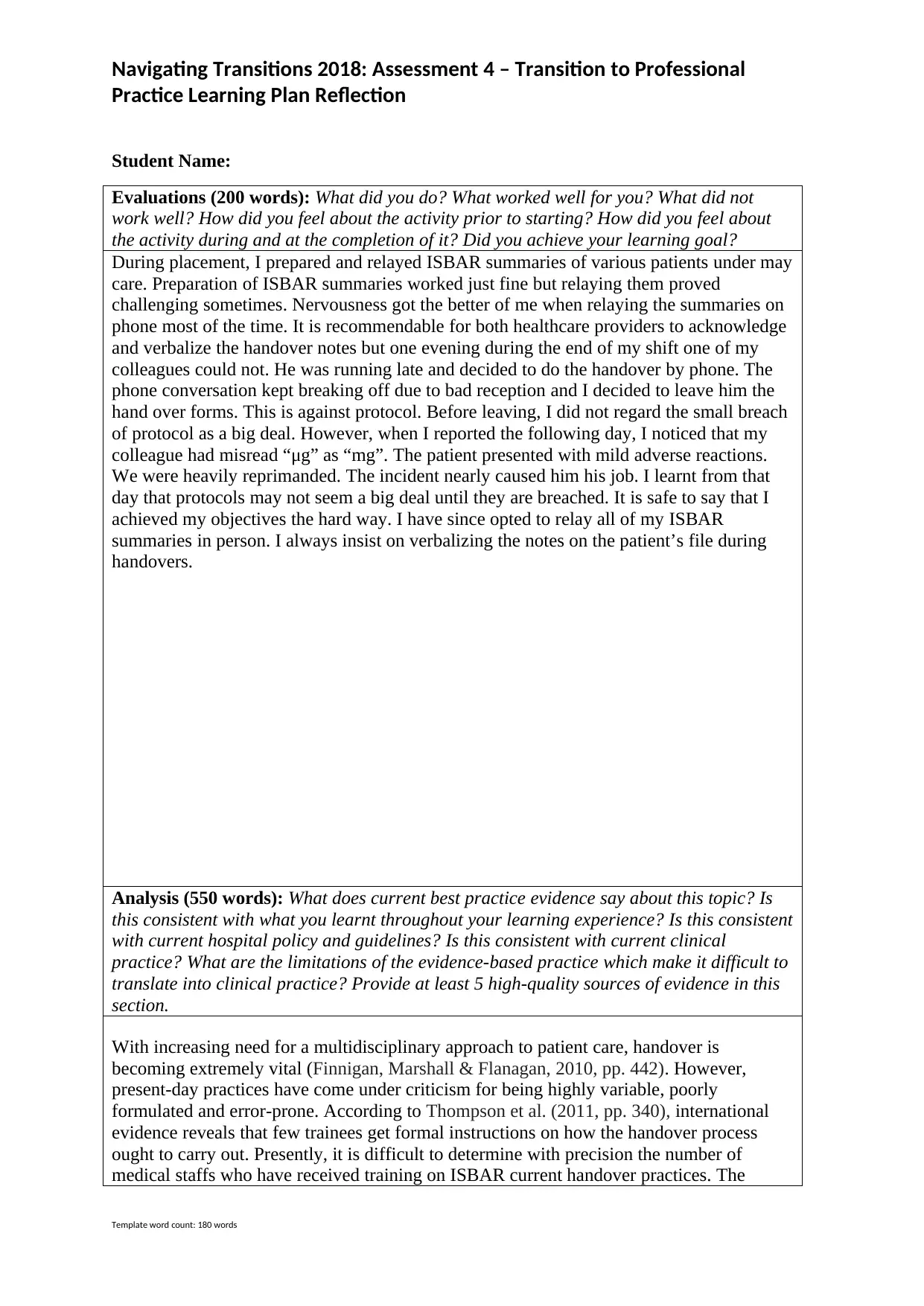
Navigating Transitions 2018: Assessment 4 – Transition to Professional
Practice Learning Plan Reflection
Student Name:
Evaluations (200 words): What did you do? What worked well for you? What did not
work well? How did you feel about the activity prior to starting? How did you feel about
the activity during and at the completion of it? Did you achieve your learning goal?
During placement, I prepared and relayed ISBAR summaries of various patients under may
care. Preparation of ISBAR summaries worked just fine but relaying them proved
challenging sometimes. Nervousness got the better of me when relaying the summaries on
phone most of the time. It is recommendable for both healthcare providers to acknowledge
and verbalize the handover notes but one evening during the end of my shift one of my
colleagues could not. He was running late and decided to do the handover by phone. The
phone conversation kept breaking off due to bad reception and I decided to leave him the
hand over forms. This is against protocol. Before leaving, I did not regard the small breach
of protocol as a big deal. However, when I reported the following day, I noticed that my
colleague had misread “μg” as “mg”. The patient presented with mild adverse reactions.
We were heavily reprimanded. The incident nearly caused him his job. I learnt from that
day that protocols may not seem a big deal until they are breached. It is safe to say that I
achieved my objectives the hard way. I have since opted to relay all of my ISBAR
summaries in person. I always insist on verbalizing the notes on the patient’s file during
handovers.
Analysis (550 words): What does current best practice evidence say about this topic? Is
this consistent with what you learnt throughout your learning experience? Is this consistent
with current hospital policy and guidelines? Is this consistent with current clinical
practice? What are the limitations of the evidence-based practice which make it difficult to
translate into clinical practice? Provide at least 5 high-quality sources of evidence in this
section.
With increasing need for a multidisciplinary approach to patient care, handover is
becoming extremely vital (Finnigan, Marshall & Flanagan, 2010, pp. 442). However,
present-day practices have come under criticism for being highly variable, poorly
formulated and error-prone. According to Thompson et al. (2011, pp. 340), international
evidence reveals that few trainees get formal instructions on how the handover process
ought to carry out. Presently, it is difficult to determine with precision the number of
medical staffs who have received training on ISBAR current handover practices. The
Template word count: 180 words
Practice Learning Plan Reflection
Student Name:
Evaluations (200 words): What did you do? What worked well for you? What did not
work well? How did you feel about the activity prior to starting? How did you feel about
the activity during and at the completion of it? Did you achieve your learning goal?
During placement, I prepared and relayed ISBAR summaries of various patients under may
care. Preparation of ISBAR summaries worked just fine but relaying them proved
challenging sometimes. Nervousness got the better of me when relaying the summaries on
phone most of the time. It is recommendable for both healthcare providers to acknowledge
and verbalize the handover notes but one evening during the end of my shift one of my
colleagues could not. He was running late and decided to do the handover by phone. The
phone conversation kept breaking off due to bad reception and I decided to leave him the
hand over forms. This is against protocol. Before leaving, I did not regard the small breach
of protocol as a big deal. However, when I reported the following day, I noticed that my
colleague had misread “μg” as “mg”. The patient presented with mild adverse reactions.
We were heavily reprimanded. The incident nearly caused him his job. I learnt from that
day that protocols may not seem a big deal until they are breached. It is safe to say that I
achieved my objectives the hard way. I have since opted to relay all of my ISBAR
summaries in person. I always insist on verbalizing the notes on the patient’s file during
handovers.
Analysis (550 words): What does current best practice evidence say about this topic? Is
this consistent with what you learnt throughout your learning experience? Is this consistent
with current hospital policy and guidelines? Is this consistent with current clinical
practice? What are the limitations of the evidence-based practice which make it difficult to
translate into clinical practice? Provide at least 5 high-quality sources of evidence in this
section.
With increasing need for a multidisciplinary approach to patient care, handover is
becoming extremely vital (Finnigan, Marshall & Flanagan, 2010, pp. 442). However,
present-day practices have come under criticism for being highly variable, poorly
formulated and error-prone. According to Thompson et al. (2011, pp. 340), international
evidence reveals that few trainees get formal instructions on how the handover process
ought to carry out. Presently, it is difficult to determine with precision the number of
medical staffs who have received training on ISBAR current handover practices. The
Template word count: 180 words
Paraphrase This Document
Need a fresh take? Get an instant paraphrase of this document with our AI Paraphraser
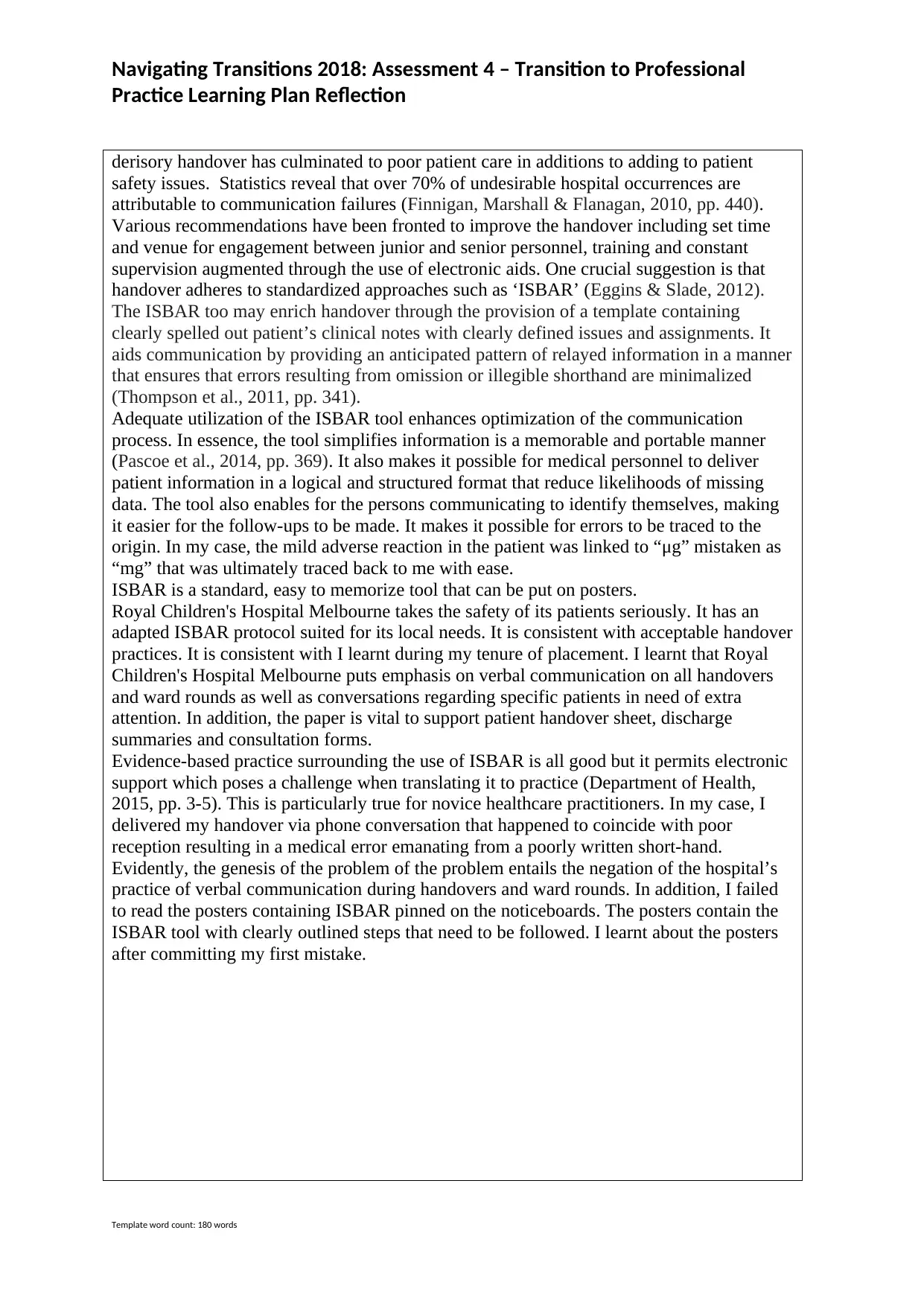
Navigating Transitions 2018: Assessment 4 – Transition to Professional
Practice Learning Plan Reflection
derisory handover has culminated to poor patient care in additions to adding to patient
safety issues. Statistics reveal that over 70% of undesirable hospital occurrences are
attributable to communication failures (Finnigan, Marshall & Flanagan, 2010, pp. 440).
Various recommendations have been fronted to improve the handover including set time
and venue for engagement between junior and senior personnel, training and constant
supervision augmented through the use of electronic aids. One crucial suggestion is that
handover adheres to standardized approaches such as ‘ISBAR’ (Eggins & Slade, 2012).
The ISBAR too may enrich handover through the provision of a template containing
clearly spelled out patient’s clinical notes with clearly defined issues and assignments. It
aids communication by providing an anticipated pattern of relayed information in a manner
that ensures that errors resulting from omission or illegible shorthand are minimalized
(Thompson et al., 2011, pp. 341).
Adequate utilization of the ISBAR tool enhances optimization of the communication
process. In essence, the tool simplifies information is a memorable and portable manner
(Pascoe et al., 2014, pp. 369). It also makes it possible for medical personnel to deliver
patient information in a logical and structured format that reduce likelihoods of missing
data. The tool also enables for the persons communicating to identify themselves, making
it easier for the follow-ups to be made. It makes it possible for errors to be traced to the
origin. In my case, the mild adverse reaction in the patient was linked to “μg” mistaken as
“mg” that was ultimately traced back to me with ease.
ISBAR is a standard, easy to memorize tool that can be put on posters.
Royal Children's Hospital Melbourne takes the safety of its patients seriously. It has an
adapted ISBAR protocol suited for its local needs. It is consistent with acceptable handover
practices. It is consistent with I learnt during my tenure of placement. I learnt that Royal
Children's Hospital Melbourne puts emphasis on verbal communication on all handovers
and ward rounds as well as conversations regarding specific patients in need of extra
attention. In addition, the paper is vital to support patient handover sheet, discharge
summaries and consultation forms.
Evidence-based practice surrounding the use of ISBAR is all good but it permits electronic
support which poses a challenge when translating it to practice (Department of Health,
2015, pp. 3-5). This is particularly true for novice healthcare practitioners. In my case, I
delivered my handover via phone conversation that happened to coincide with poor
reception resulting in a medical error emanating from a poorly written short-hand.
Evidently, the genesis of the problem of the problem entails the negation of the hospital’s
practice of verbal communication during handovers and ward rounds. In addition, I failed
to read the posters containing ISBAR pinned on the noticeboards. The posters contain the
ISBAR tool with clearly outlined steps that need to be followed. I learnt about the posters
after committing my first mistake.
Template word count: 180 words
Practice Learning Plan Reflection
derisory handover has culminated to poor patient care in additions to adding to patient
safety issues. Statistics reveal that over 70% of undesirable hospital occurrences are
attributable to communication failures (Finnigan, Marshall & Flanagan, 2010, pp. 440).
Various recommendations have been fronted to improve the handover including set time
and venue for engagement between junior and senior personnel, training and constant
supervision augmented through the use of electronic aids. One crucial suggestion is that
handover adheres to standardized approaches such as ‘ISBAR’ (Eggins & Slade, 2012).
The ISBAR too may enrich handover through the provision of a template containing
clearly spelled out patient’s clinical notes with clearly defined issues and assignments. It
aids communication by providing an anticipated pattern of relayed information in a manner
that ensures that errors resulting from omission or illegible shorthand are minimalized
(Thompson et al., 2011, pp. 341).
Adequate utilization of the ISBAR tool enhances optimization of the communication
process. In essence, the tool simplifies information is a memorable and portable manner
(Pascoe et al., 2014, pp. 369). It also makes it possible for medical personnel to deliver
patient information in a logical and structured format that reduce likelihoods of missing
data. The tool also enables for the persons communicating to identify themselves, making
it easier for the follow-ups to be made. It makes it possible for errors to be traced to the
origin. In my case, the mild adverse reaction in the patient was linked to “μg” mistaken as
“mg” that was ultimately traced back to me with ease.
ISBAR is a standard, easy to memorize tool that can be put on posters.
Royal Children's Hospital Melbourne takes the safety of its patients seriously. It has an
adapted ISBAR protocol suited for its local needs. It is consistent with acceptable handover
practices. It is consistent with I learnt during my tenure of placement. I learnt that Royal
Children's Hospital Melbourne puts emphasis on verbal communication on all handovers
and ward rounds as well as conversations regarding specific patients in need of extra
attention. In addition, the paper is vital to support patient handover sheet, discharge
summaries and consultation forms.
Evidence-based practice surrounding the use of ISBAR is all good but it permits electronic
support which poses a challenge when translating it to practice (Department of Health,
2015, pp. 3-5). This is particularly true for novice healthcare practitioners. In my case, I
delivered my handover via phone conversation that happened to coincide with poor
reception resulting in a medical error emanating from a poorly written short-hand.
Evidently, the genesis of the problem of the problem entails the negation of the hospital’s
practice of verbal communication during handovers and ward rounds. In addition, I failed
to read the posters containing ISBAR pinned on the noticeboards. The posters contain the
ISBAR tool with clearly outlined steps that need to be followed. I learnt about the posters
after committing my first mistake.
Template word count: 180 words
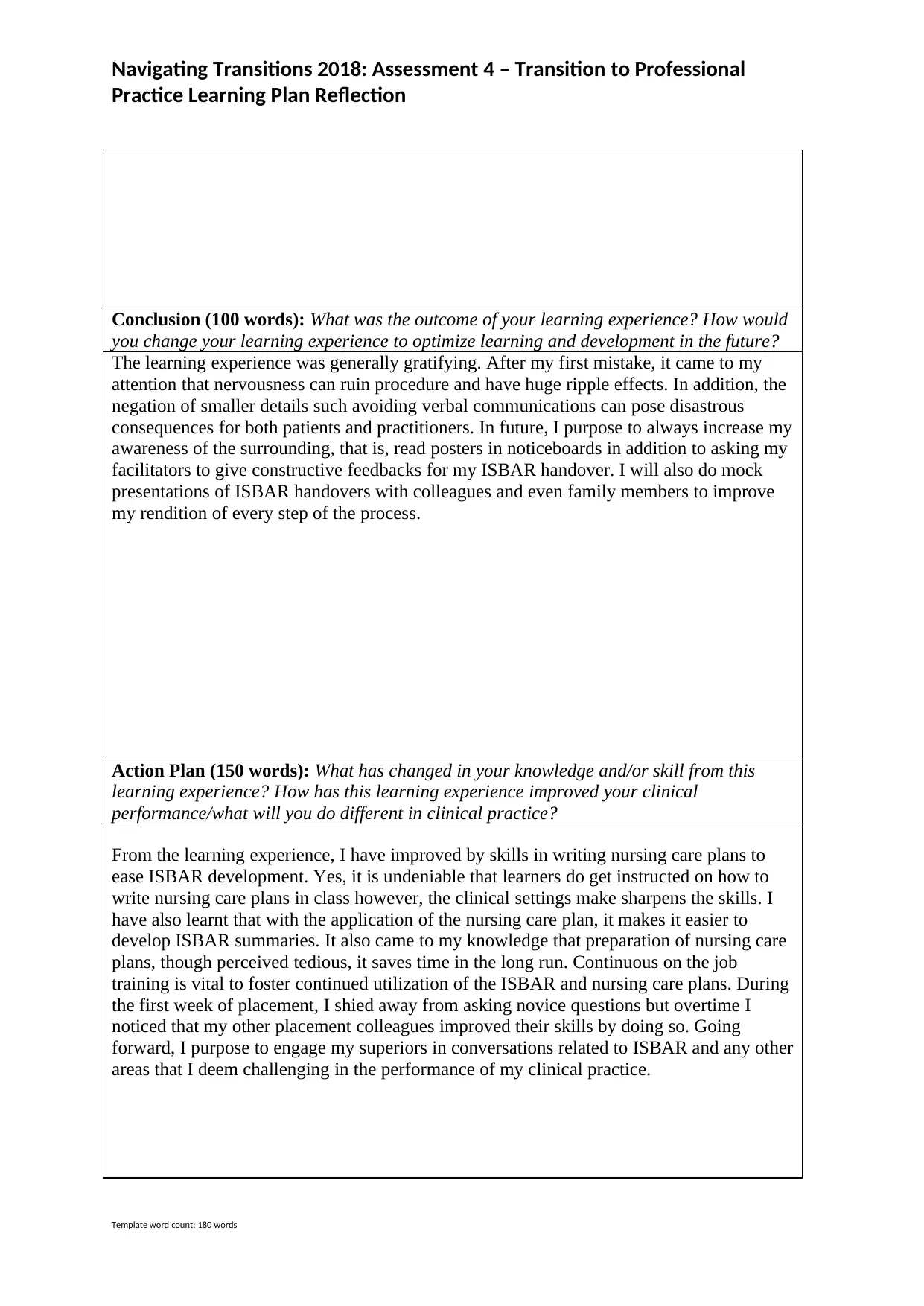
Navigating Transitions 2018: Assessment 4 – Transition to Professional
Practice Learning Plan Reflection
Conclusion (100 words): What was the outcome of your learning experience? How would
you change your learning experience to optimize learning and development in the future?
The learning experience was generally gratifying. After my first mistake, it came to my
attention that nervousness can ruin procedure and have huge ripple effects. In addition, the
negation of smaller details such avoiding verbal communications can pose disastrous
consequences for both patients and practitioners. In future, I purpose to always increase my
awareness of the surrounding, that is, read posters in noticeboards in addition to asking my
facilitators to give constructive feedbacks for my ISBAR handover. I will also do mock
presentations of ISBAR handovers with colleagues and even family members to improve
my rendition of every step of the process.
Action Plan (150 words): What has changed in your knowledge and/or skill from this
learning experience? How has this learning experience improved your clinical
performance/what will you do different in clinical practice?
From the learning experience, I have improved by skills in writing nursing care plans to
ease ISBAR development. Yes, it is undeniable that learners do get instructed on how to
write nursing care plans in class however, the clinical settings make sharpens the skills. I
have also learnt that with the application of the nursing care plan, it makes it easier to
develop ISBAR summaries. It also came to my knowledge that preparation of nursing care
plans, though perceived tedious, it saves time in the long run. Continuous on the job
training is vital to foster continued utilization of the ISBAR and nursing care plans. During
the first week of placement, I shied away from asking novice questions but overtime I
noticed that my other placement colleagues improved their skills by doing so. Going
forward, I purpose to engage my superiors in conversations related to ISBAR and any other
areas that I deem challenging in the performance of my clinical practice.
Template word count: 180 words
Practice Learning Plan Reflection
Conclusion (100 words): What was the outcome of your learning experience? How would
you change your learning experience to optimize learning and development in the future?
The learning experience was generally gratifying. After my first mistake, it came to my
attention that nervousness can ruin procedure and have huge ripple effects. In addition, the
negation of smaller details such avoiding verbal communications can pose disastrous
consequences for both patients and practitioners. In future, I purpose to always increase my
awareness of the surrounding, that is, read posters in noticeboards in addition to asking my
facilitators to give constructive feedbacks for my ISBAR handover. I will also do mock
presentations of ISBAR handovers with colleagues and even family members to improve
my rendition of every step of the process.
Action Plan (150 words): What has changed in your knowledge and/or skill from this
learning experience? How has this learning experience improved your clinical
performance/what will you do different in clinical practice?
From the learning experience, I have improved by skills in writing nursing care plans to
ease ISBAR development. Yes, it is undeniable that learners do get instructed on how to
write nursing care plans in class however, the clinical settings make sharpens the skills. I
have also learnt that with the application of the nursing care plan, it makes it easier to
develop ISBAR summaries. It also came to my knowledge that preparation of nursing care
plans, though perceived tedious, it saves time in the long run. Continuous on the job
training is vital to foster continued utilization of the ISBAR and nursing care plans. During
the first week of placement, I shied away from asking novice questions but overtime I
noticed that my other placement colleagues improved their skills by doing so. Going
forward, I purpose to engage my superiors in conversations related to ISBAR and any other
areas that I deem challenging in the performance of my clinical practice.
Template word count: 180 words
⊘ This is a preview!⊘
Do you want full access?
Subscribe today to unlock all pages.

Trusted by 1+ million students worldwide
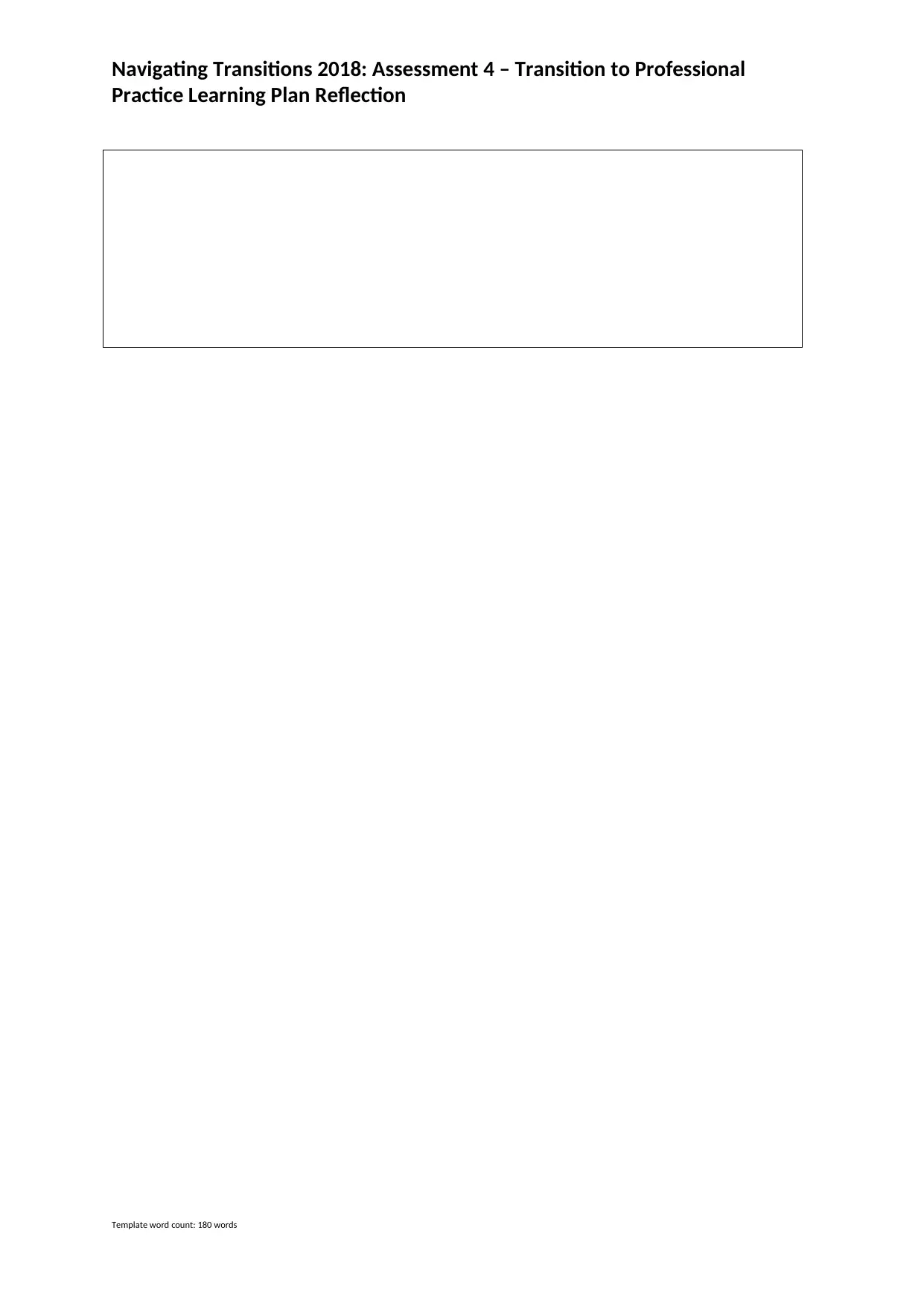
Navigating Transitions 2018: Assessment 4 – Transition to Professional
Practice Learning Plan Reflection
Template word count: 180 words
Practice Learning Plan Reflection
Template word count: 180 words
Paraphrase This Document
Need a fresh take? Get an instant paraphrase of this document with our AI Paraphraser
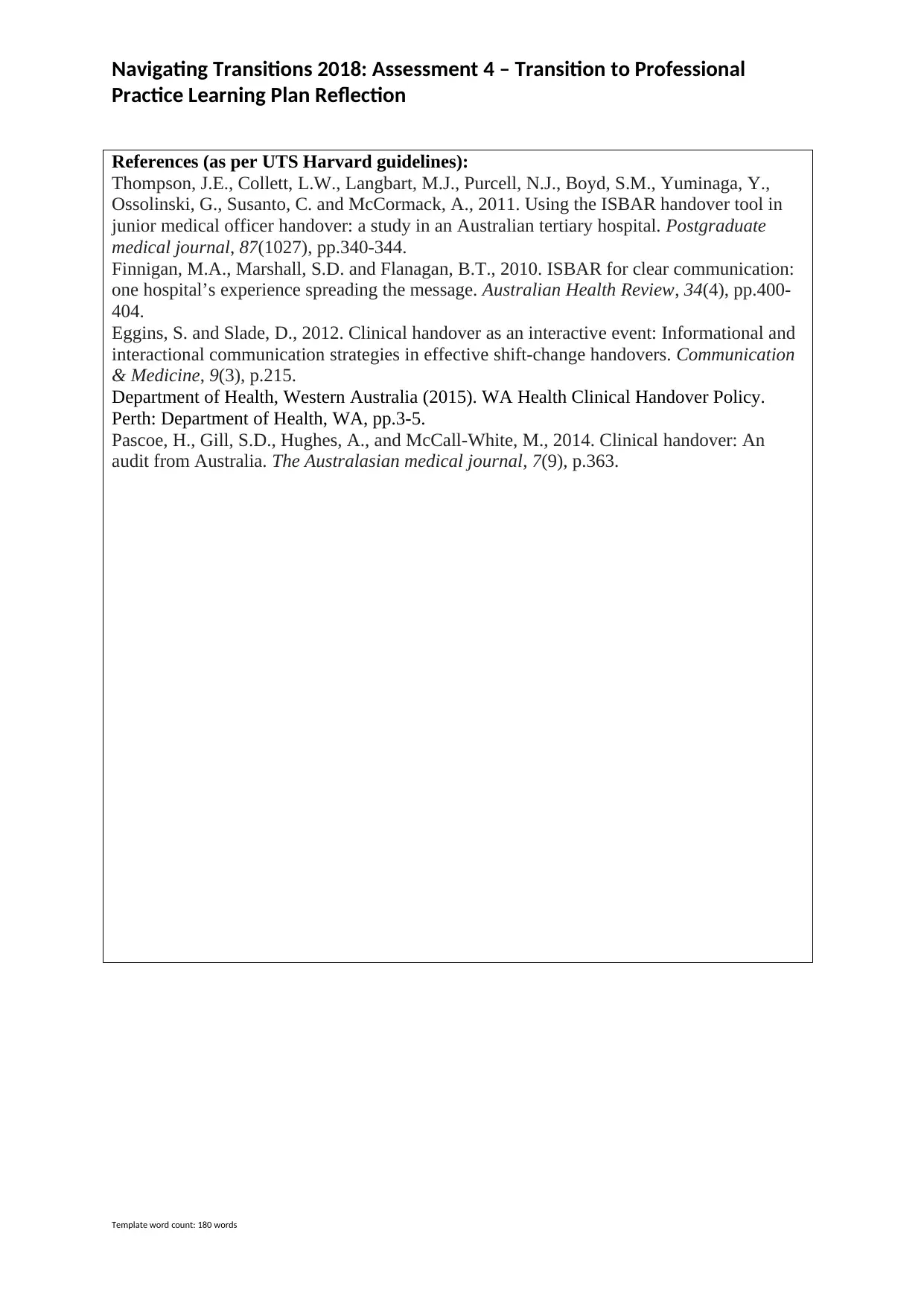
Navigating Transitions 2018: Assessment 4 – Transition to Professional
Practice Learning Plan Reflection
References (as per UTS Harvard guidelines):
Thompson, J.E., Collett, L.W., Langbart, M.J., Purcell, N.J., Boyd, S.M., Yuminaga, Y.,
Ossolinski, G., Susanto, C. and McCormack, A., 2011. Using the ISBAR handover tool in
junior medical officer handover: a study in an Australian tertiary hospital. Postgraduate
medical journal, 87(1027), pp.340-344.
Finnigan, M.A., Marshall, S.D. and Flanagan, B.T., 2010. ISBAR for clear communication:
one hospital’s experience spreading the message. Australian Health Review, 34(4), pp.400-
404.
Eggins, S. and Slade, D., 2012. Clinical handover as an interactive event: Informational and
interactional communication strategies in effective shift-change handovers. Communication
& Medicine, 9(3), p.215.
Department of Health, Western Australia (2015). WA Health Clinical Handover Policy.
Perth: Department of Health, WA, pp.3-5.
Pascoe, H., Gill, S.D., Hughes, A., and McCall-White, M., 2014. Clinical handover: An
audit from Australia. The Australasian medical journal, 7(9), p.363.
Template word count: 180 words
Practice Learning Plan Reflection
References (as per UTS Harvard guidelines):
Thompson, J.E., Collett, L.W., Langbart, M.J., Purcell, N.J., Boyd, S.M., Yuminaga, Y.,
Ossolinski, G., Susanto, C. and McCormack, A., 2011. Using the ISBAR handover tool in
junior medical officer handover: a study in an Australian tertiary hospital. Postgraduate
medical journal, 87(1027), pp.340-344.
Finnigan, M.A., Marshall, S.D. and Flanagan, B.T., 2010. ISBAR for clear communication:
one hospital’s experience spreading the message. Australian Health Review, 34(4), pp.400-
404.
Eggins, S. and Slade, D., 2012. Clinical handover as an interactive event: Informational and
interactional communication strategies in effective shift-change handovers. Communication
& Medicine, 9(3), p.215.
Department of Health, Western Australia (2015). WA Health Clinical Handover Policy.
Perth: Department of Health, WA, pp.3-5.
Pascoe, H., Gill, S.D., Hughes, A., and McCall-White, M., 2014. Clinical handover: An
audit from Australia. The Australasian medical journal, 7(9), p.363.
Template word count: 180 words
1 out of 5
Related Documents
Your All-in-One AI-Powered Toolkit for Academic Success.
+13062052269
info@desklib.com
Available 24*7 on WhatsApp / Email
![[object Object]](/_next/static/media/star-bottom.7253800d.svg)
Unlock your academic potential
Copyright © 2020–2026 A2Z Services. All Rights Reserved. Developed and managed by ZUCOL.





